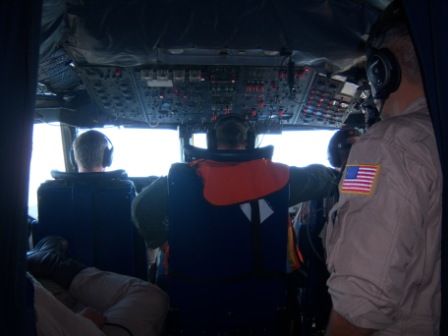Homestead, Florida 7:35 a.m.
Rafael Rincon:
Good morning! It’s early here, but we have been working already for a few hours. I’m standing outside the airplane, and we are getting ready to board for today’s flight. We made sure that everything is in place, and we are ready to go, as soon as they call us inside the plane.
I missed calling in last night, and I hate that. It was just a long, very busy day. I took the computer back to the hotel room and had a lot of work to do. Then when I got there, I found out that I had left the cables with the plane, and had to try to get the computer workable around that – so it took a lot of extra time. But I’ll share yesterday’s work now.

Yesterday we flew over two sites near Wallops, then we few over a spot in Maryland. That’s called the Smithsonian Environmental Research Center or SERC. There have been a lot of ground-truth measurements taken recently there, so it is a very good site for us. We used the DBSAR first thing and did a full data collection over SERC. The instrument worked really well, and the data collection was excellent. Then we flew lines for CAR to acquire its data. We’re very happy with the SERC flights.
After that, we flew to North Carolina and spent time flying over the Parker Tract. This site is part of NASA’s Carbon Monitoring System initiative, and scientists from that program have been out in the past few months making ground-truth measurements here. There is an excellent data set from the ground, and now our instruments have been able to get an excellent dataset from the air as well.
In North Carolina, we ran the SIMPL instrument first, and CAR also acquired data. When we ran the DBSAR, a few glitches showed back up again. We don’t like that, but we still can do good science out of North Carolina data sets.
After those flights, we transited to Florida. We landed at Homestead Air force Base, and are staying nearby. The weather looks great for the morning flight – it should stay clear until at least noon-so we’re excited to get going here and run our instruments as long as we can today over our sites – mostly over the Everglades. This is a different ecosystem than our other sites. The vegetation is primarily mangrove forests.

The plan from here is to fly the Everglades today, using DBSAR mostly but also SIMPL and CAR. We’ll stay over in Florida one night, and fly our sites here again on Wednesday, then transit back to Wallops. That means we’ll still have Thursday and maybe Friday to do more work. We might head north again. We’d very much like to be able to fly the boulder field in Pennsylvania.
Why study rocks, when Eco 3D is primarily for vegetation? There are two reasons. First of all, flying over boulders helps us acquire data on non-vegetated areas, and this is helpful. Secondly, some of us are quite interested in planetary applications, especially for our radar. We want to be able to understand the geology of rocky surfaces, not just on Earth, but also surfaces that resemble those on Mars and Venus. Eventually we’d like to put radar on one of those planets, to help characterize and learn about the geology. Combining radar and lidar for geological purposes is very interesting.
When we go to the boulder field, we will be using polarimetric and interferometric techniques. This is completely experimental, and the first time we have measured boulder fields like this.
Oh, I should also fill you in a little about last week. I brought the computer home with me, to Maryland after our last flights. I put a monitor on it and worked much of the week to figure out our troubles. On Wednesday I went back to Wallops, and installed the DBSAR in a different location on the plane.
When we started to fly the first time, we had to install our computer on a new rack. That rack is very stiff and doesn’t dampen vibration at all – it actually can introduce additional vibration into the computer. Also, the rack was located right where the vibration is the highest – very close the propellers. What we did last week was to move the rack. We are now near the cockpit, in what they call “first class”. It’s a joke – there’s no first class section on this P3! But we are now in the front of the plane and the vibration is much less here. It’s really surprising – if you go stand where we used to be and then walk here, when the aircraft is running, you can feel a difference. We think this it is going to be very good for the DBSAR, to have less vibration.
It’s seemed to help so far. But still we have a small glitch. We lose small chunks of data every once in awhile. So despite the work this week, and despite moving the rack, there is still something we need to fix. And we are working on it. We will be doing a massive data collection over Florida today, so it will really test the instrument fully.
We’ve got to go now. The engines are spinning and they are saying it’s time to leave! I need to sign off. I’ll talk to you later and let you know how our Florida trip goes.



